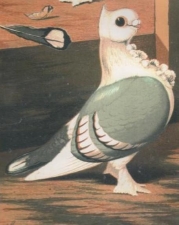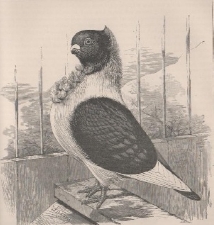- History of Oriental Frills
- Shortface Standards
- Show Reports
- British Nun Club
- Breeding Nuns
- British Nun Standard
- Nun Club Results
- Nun Club History
- BPSS Exhibition News
- BPSS History
- BPSS Trophies
- BPSS Regs
- BPSS Hall of Fame
- BPSS Classification
- BPSS Entry Form
- Show Hall
- Gallery
- Fancy Pigeon Gallery
- BPSS Best In Show Winners
- Fanciers
- Housing
- Hints & Tips
- Donovon White, USA
- Ludlow
- National Peristeronic Soc
- Sale Birds
- Pointing The Way
- Show Dates
- BPSS Section Winners
- Directions
- LINKS
The History of Oriental Frills

Whilst the English fancier of today is strolling round his modern up-to-date lofts. noting with intent, observant eye the beauty of their names, he probably seldom, if ever, pauses to realize that the hobby which so delights him is one, the origin of which stretches away into an antiquity so remote that no authentic account of it can be actually presented.
It is generally conceded that the breeding and barter of pigeons was a recognized industry several thousand years ago. Not only do references to it occur from time to time in classical writing, when a chance allusion often reveals, as in a flash, the eager striving and friendly rivalry that made the Columbaria of Greece and Rome a center of interest as keen as any that today kindles the enthusiasm of competitors in our own National Shows.
It has been proved by the leading pigeon writers of all countries that the numerous varieties known to the pigeon world of today, no matter how widely divergent may be their present characteristics, both of form and colour, have a common ancestor in the wild Blue Rock Pigeon, and every type has been slowly evolved through numberless years by the patient endeavours of a long line of breeders. The attainment of an ideal, is a labour of love and it is quite impossible to fix the periods at which the various recognized types were being evolved, it is, however, certain that developments in these directions had made long strides at a very early date. Amongst the varieties produced in those far-off ages that which was the progenitor of the Oriental Frill undoubtedly took a prominent place.
Although the earliest records do not disclose any mention of Oriental Frills, even in a primitive state, being found outside Asia Minor, yet the other shores of the Mediterranean, and more particularly those of the south, have a very strong claim to be the original home of the oriental type. Not that there is any evidence to discredit Asia Minor as the producer of lacing, and the other beautiful colour properties of Oriental Frills. The first African Owls were imported from Tunis, about the year 1857, the native fanciers had apparently no knowledge of Oriental Frills as they were, and it was not until some five years later that the English fancy was introduced to the charming Satinette by Mr.H.P Caridia, a Greek merchant, of Smyrna, who arrived with several pairs of Blue-laced Satinettes and Brunettes. For over twenty years Mr. Caridia was the recognized authority on Orientals, and he finally left for Smyrna in 1884, where he died some nine years later. He had however, written some very interesting notes in "Fulton's Book Of Pigeons" relating that Satinettes (blue-laced) were the oldest pencilled variety which he had been enabled to trace, and that, although in his researches he had succeded in following their history as special inhabitants of Asia Minor back to somewhere about the year 1750, even then their origin was obscure, and that although he had sought in various directions to obtain a direct clue to their original birthplace, or origin, he could not get beyond the information of an aged Presbyter in Smyrna, who was then upwards of eighty years old, and he had kept the breed all his life, and who stated that the identical variety had also been bred and propagated by his father in a like manner, and by his grandfather, too, before them and that they were regarded as of the highest type of pigeon beauty, and were described in native terms, which, interpreted, would mean Royal or Imperial pigeon, as possessing the foremost order of excellence, and thus worthy of the highest title which their owners could confer upon them.
As to the origin of lacing, the most beautiful and distinctive feature of the main branch of the Oriental family, Mr. Caridia has nothing definite to say beyond the fact that the pencilled varieties of his day revealed the wonderful embodiment of three or more colours arranged in perfect and marvelous order and regularity upon every feather which should be coloured. Therefore, in order to secure this remarkable variegation in regularity and unison, the colour must necessarily have been infused at the outset by a judicious and completer system of crossing and blending of the various coloured specimens which bore the stamp and image in points of formation of one kind.



A group of Blondinettes showing their range of colour.



The Vizor was Satinette marked but with the mask like that of a Domino.

A group of Satinettes.

A colour plate by Ludlow of a group of Satinettes. Classic Old Frills are now being bred to resemble these original ancestors.

A group of the various varieties of Frills.

Painting of a Satinette by Ludlow 1892

Painting by Ludlow of a black Domino. A clean legged variety of Oriental Frill.

Painting of an Oriental Turbit by Ludlow. Clean legged and plain headed.

Painting of a Turbiteen by Ludlow, note that in this era they came plain headed, as well as with a peak.



